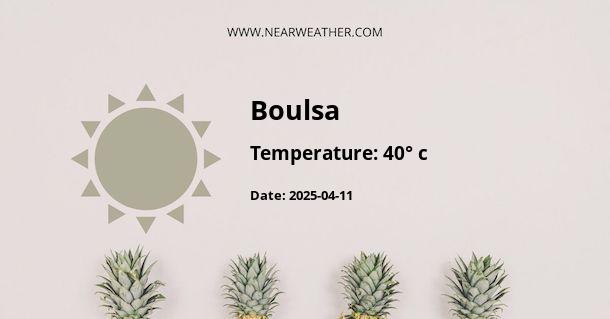Climate and Weather in Boulsa, Burkina Faso
Boulsa is a town located in the northern part of Burkina Faso, a landlocked country in West Africa. As with many areas in this region, Boulsa experiences a semi-arid climate with distinct wet and dry seasons. Understanding the climate and weather patterns in Boulsa is essential for residents, travelers, and anyone interested in the region's agricultural activities.
Temperature
The temperature in Boulsa varies greatly throughout the year. The hottest months are typically April and May, with average high temperatures reaching around 38°C (100°F). January and February are the coolest months, with average temperatures around 19°C (66°F) during the day.
During the dry season, which lasts from October to April, temperatures can be extremely high, often exceeding 40°C (104°F) during the day. However, nights can be significantly cooler, with temperatures dropping to around 15°C (59°F). In contrast, during the wet season, from May to September, temperatures are generally more moderate, ranging between 25°C (77°F) and 35°C (95°F) during the day.
Rainfall
Boulsa experiences a distinct wet and dry season, with the majority of rainfall occurring between May and September. During this period, the town receives an average of 800mm (31 inches) of rainfall per year. The wettest months are typically July and August, with precipitation reaching around 200mm (8 inches) during these months.
The dry season, from October to April, is characterized by minimal rainfall. November and December are the driest months, with little to no precipitation. This lack of rain during the dry season contributes to the arid conditions experienced in Boulsa and the surrounding region.
Wind and Dust
Like many areas in the Sahel region, Boulsa is affected by the Harmattan winds, which blow from the northeast between November and March. These winds carry dust particles from the Sahara Desert, reducing visibility and creating hazy conditions. The Harmattan winds can also contribute to dryness in the atmosphere, making the dry season even more arid.
Agricultural Implications
The climate in Boulsa poses certain challenges for agriculture. The dry season, with its high temperatures and lack of rainfall, makes it difficult for crops to thrive. Farmers often rely on irrigation systems to sustain their crops during this period. The wet season, on the other hand, provides an opportunity for agricultural activities, with farmers planting and harvesting crops such as millet, sorghum, and maize.
However, the variability in rainfall patterns in recent years has presented challenges for farmers. Climate change has resulted in unpredictable weather patterns, with some years experiencing prolonged dry spells and others witnessing excessive rainfall. Farmers in Boulsa must adapt their farming practices to cope with these changing conditions and ensure food security for the region.
Conclusion
Boulsa's climate is characterized by a semi-arid environment with distinct wet and dry seasons. High temperatures, particularly during the dry season, and limited rainfall pose challenges for agriculture and daily life in the region. Understanding these weather patterns is crucial for planning agricultural activities, managing water resources, and adapting to the impacts of climate change. As Boulsa continues to develop and grow, it is essential to consider the climate and weather conditions to ensure sustainable practices and resilience in the face of changing environmental dynamics.
A - Boulsa's Latitude is 12.667500 & Longitude is -0.575830.
A - Weather in Boulsa is 40° today.
A - Climate Conditions in Boulsa shows overcast clouds today.
A - Humidity in Boulsa is 16% today.
A - Wind speed in Boulsa is 12.6 km/h, flowing at 118° wind direction. today.
